History of the English Language 2011 -2012 Academic
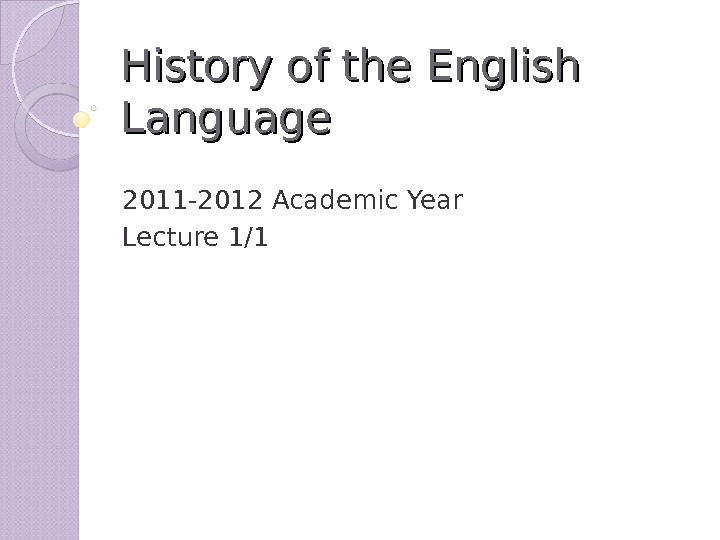

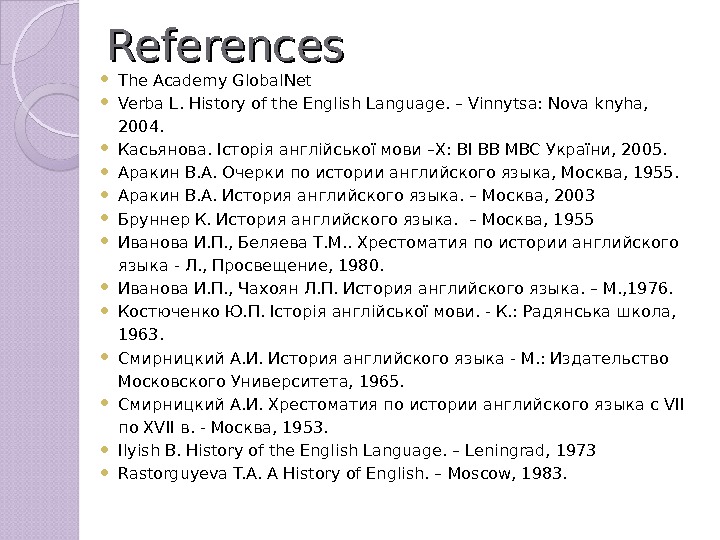

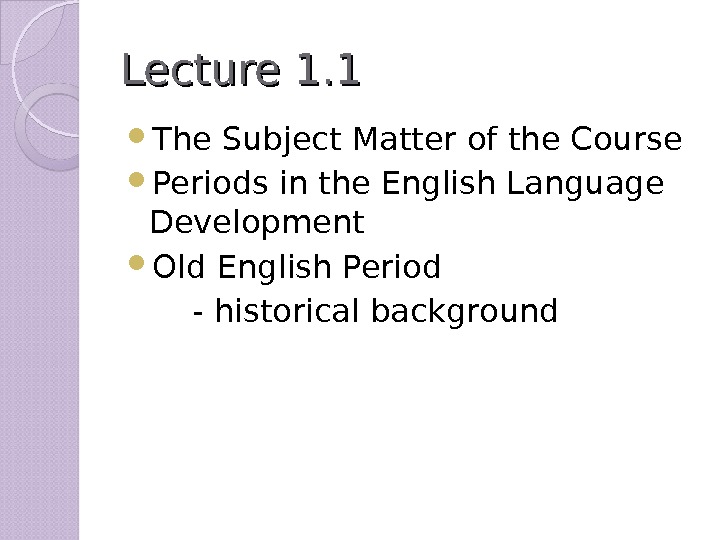

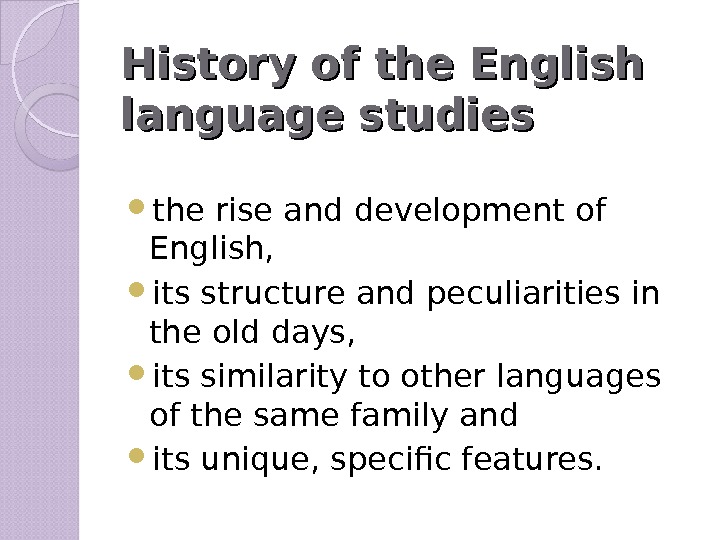






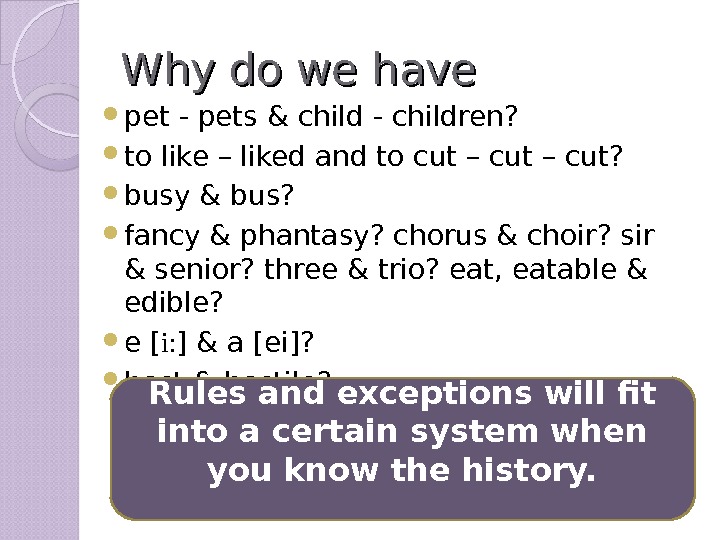
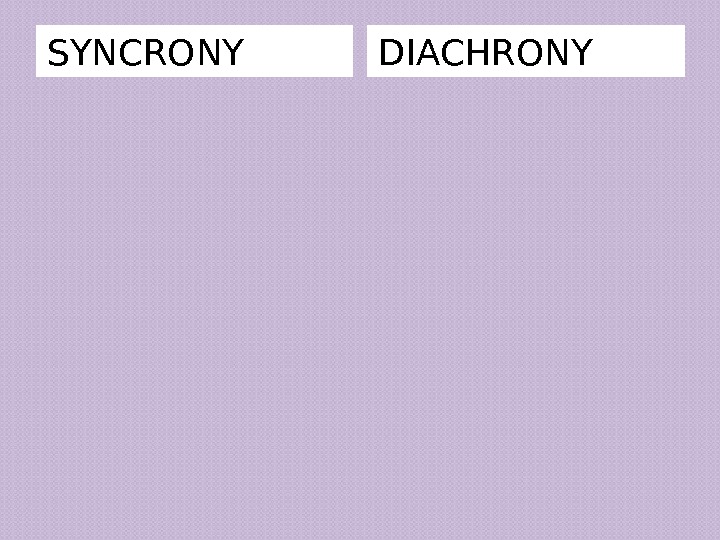
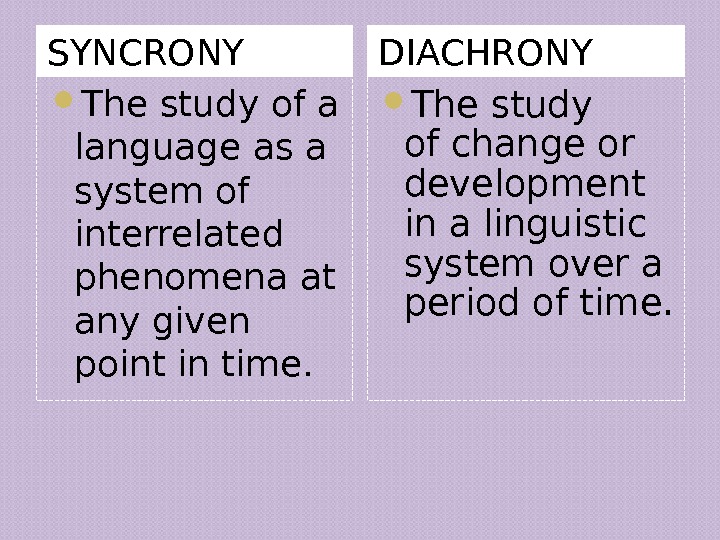

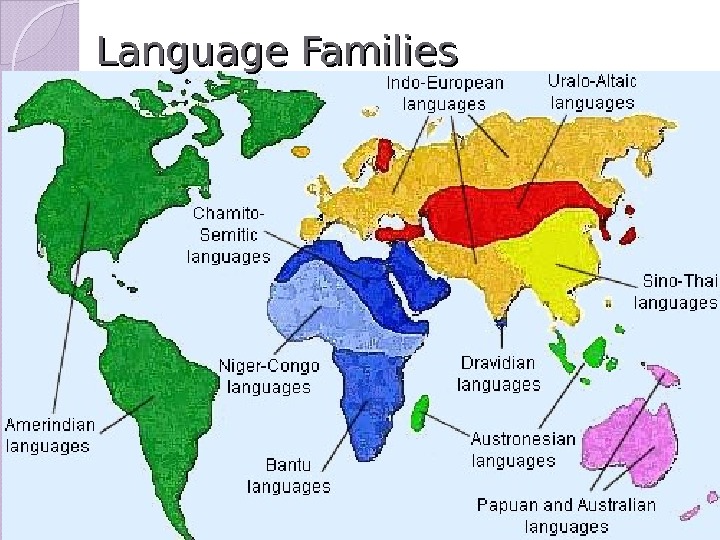
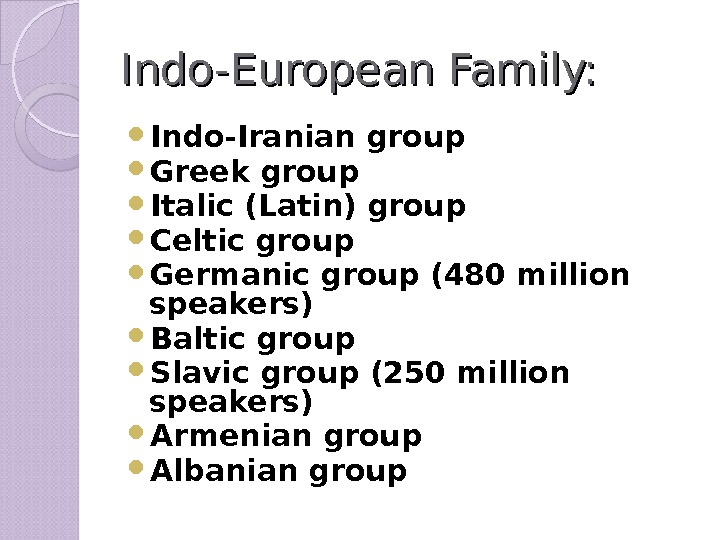

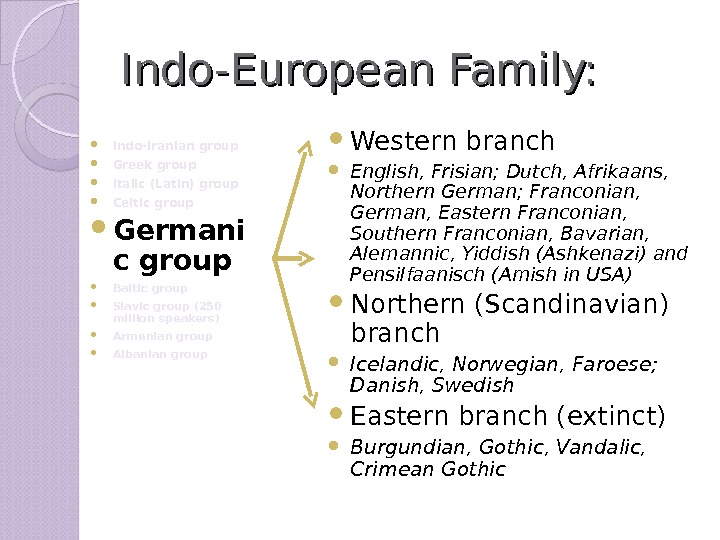
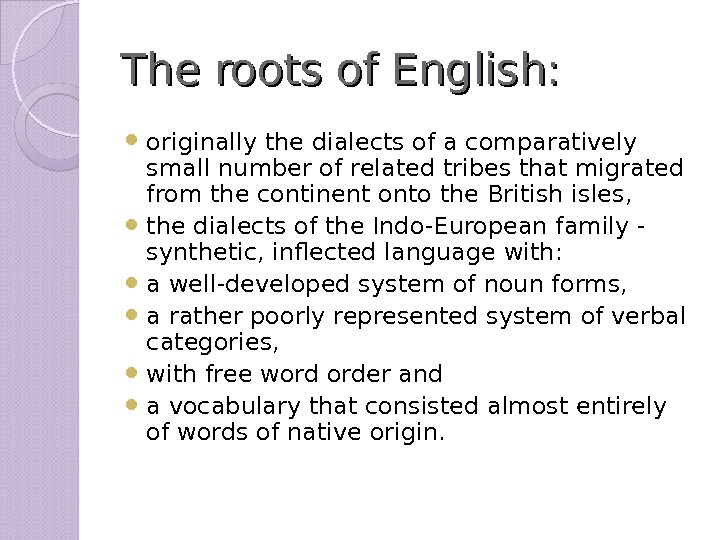
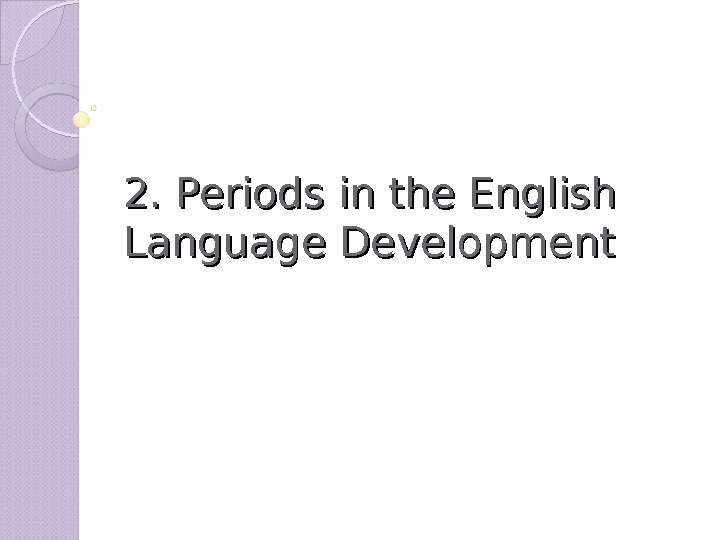
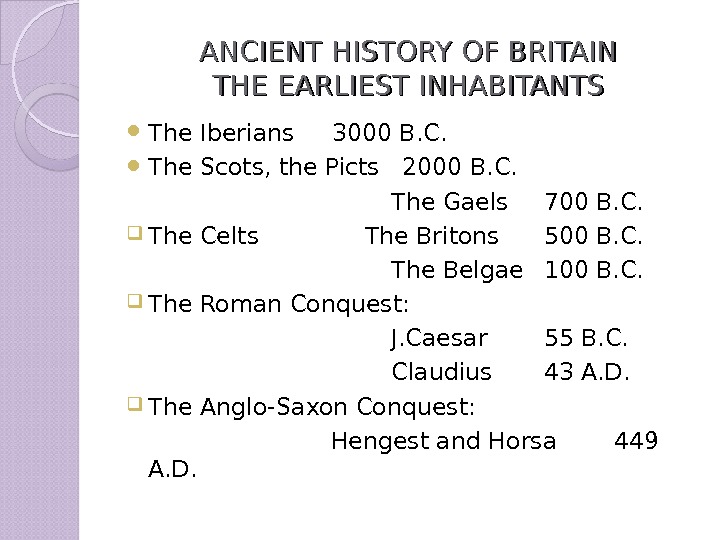
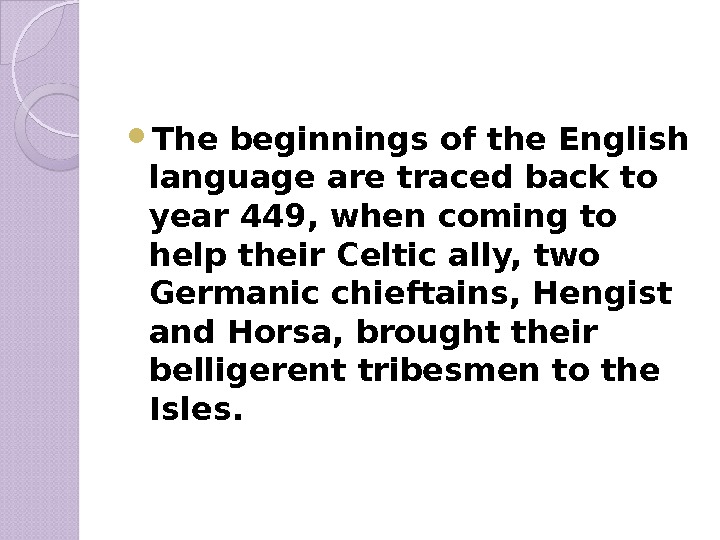


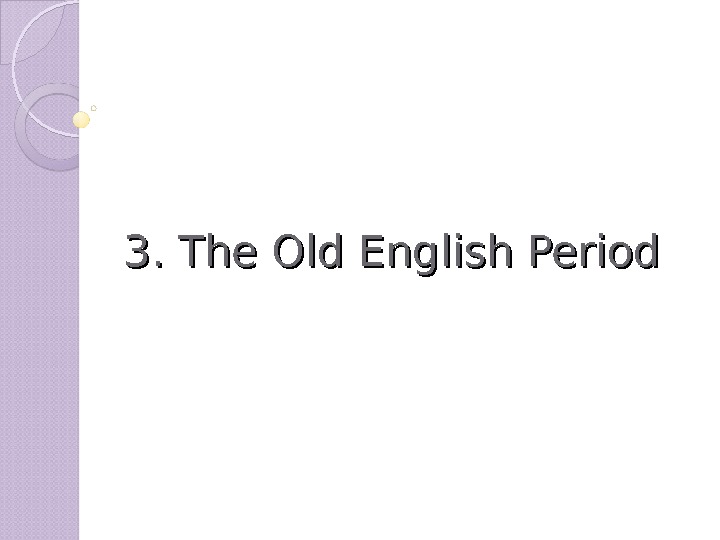
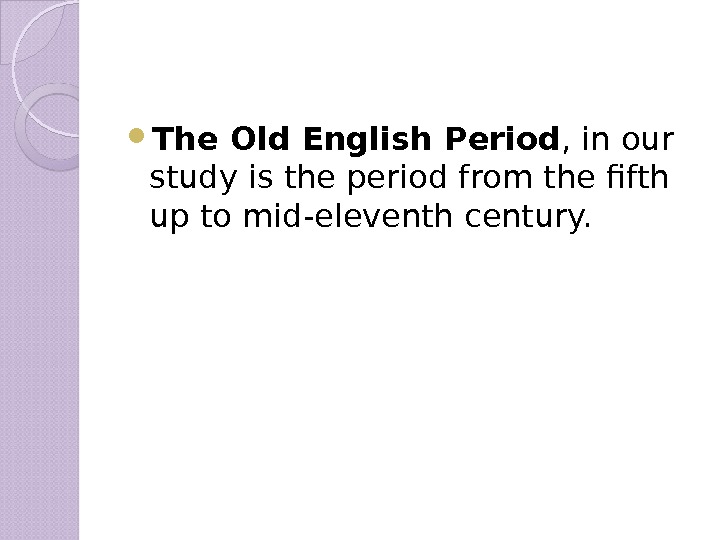
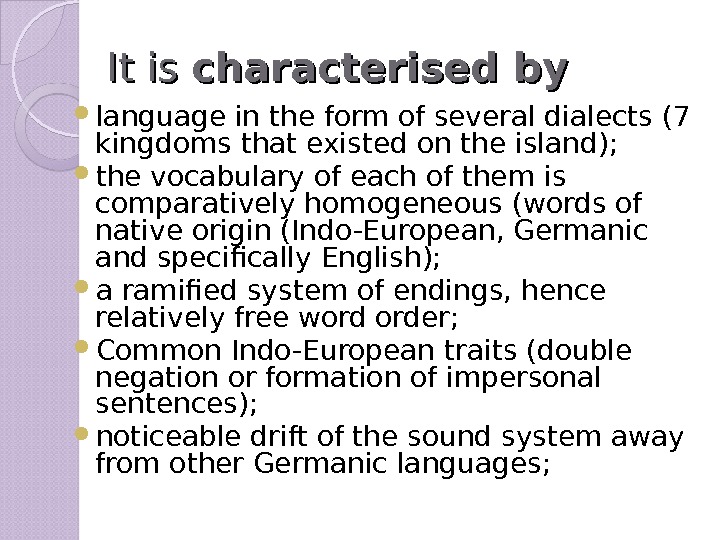
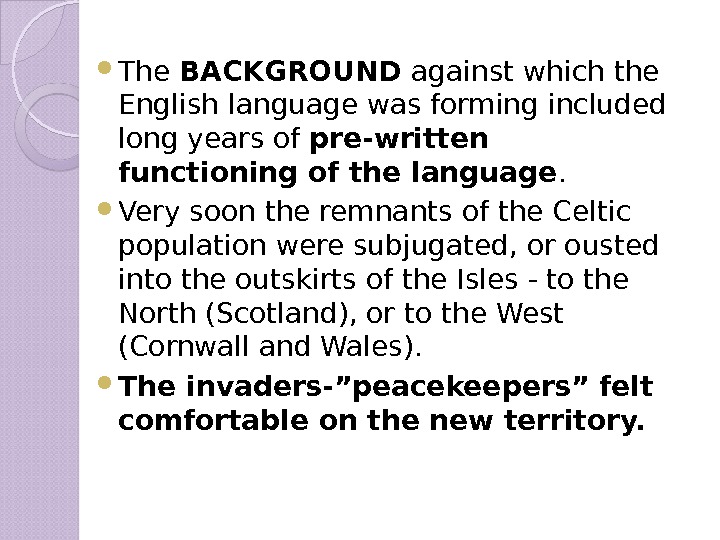
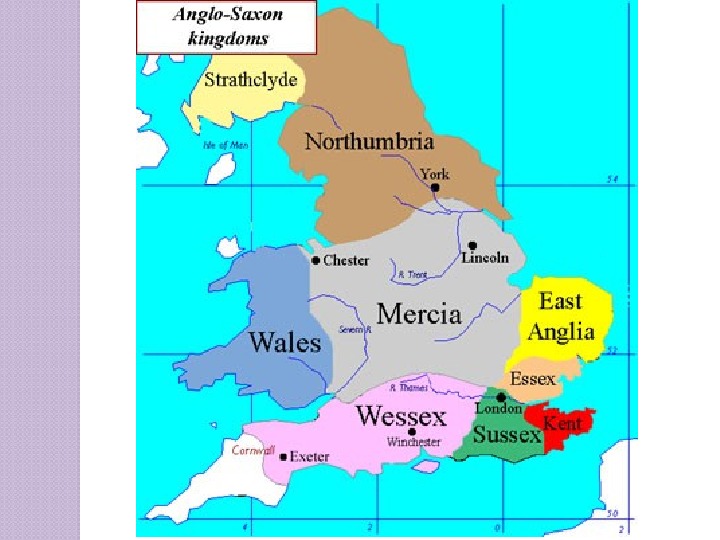
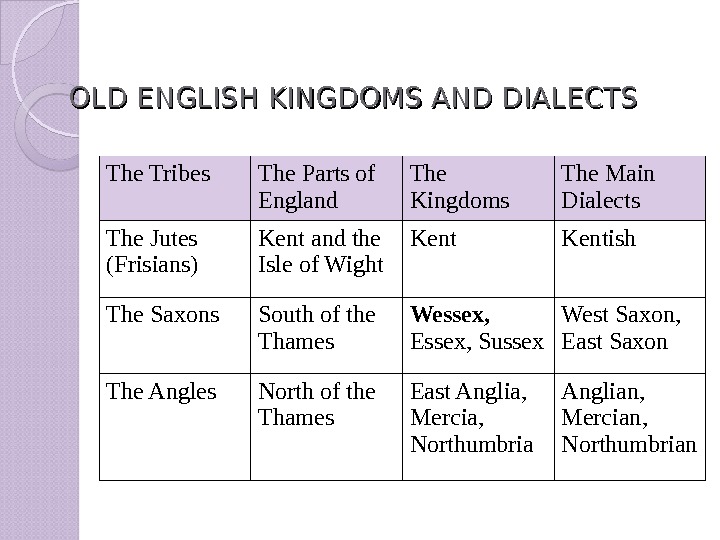
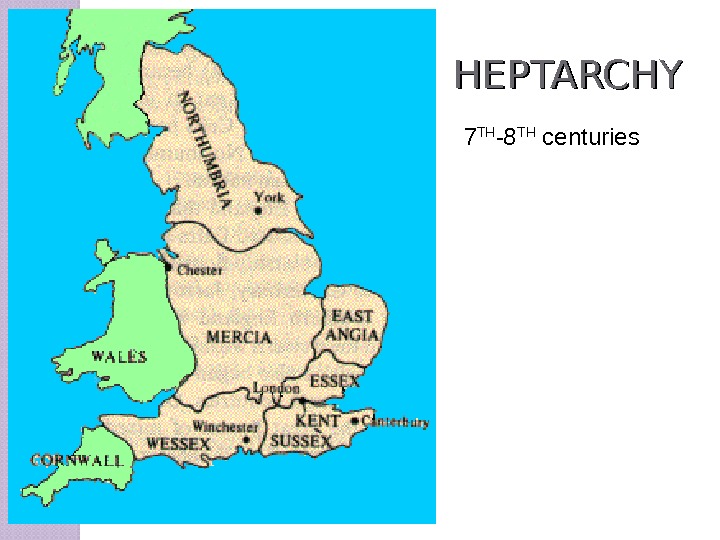
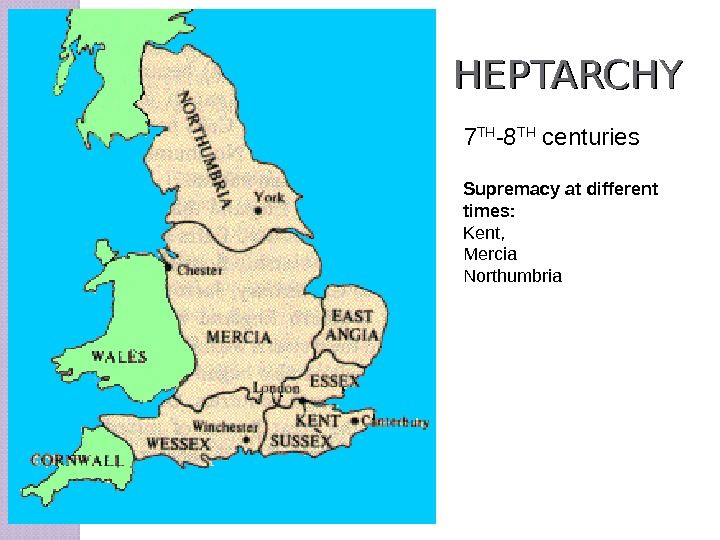
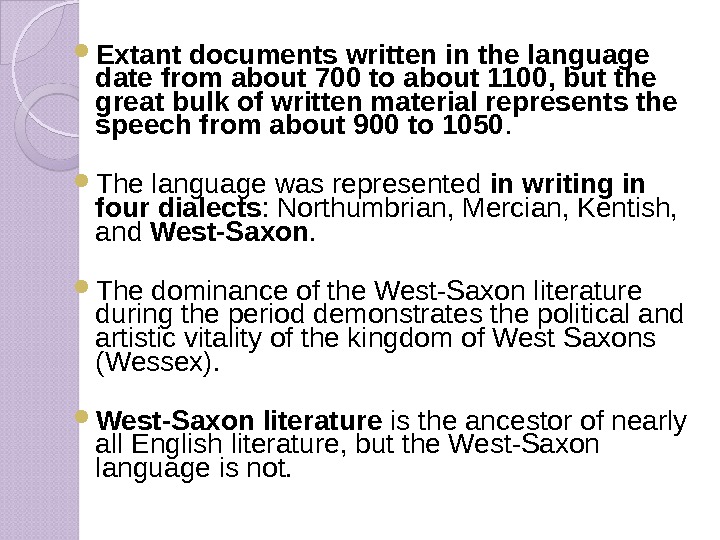
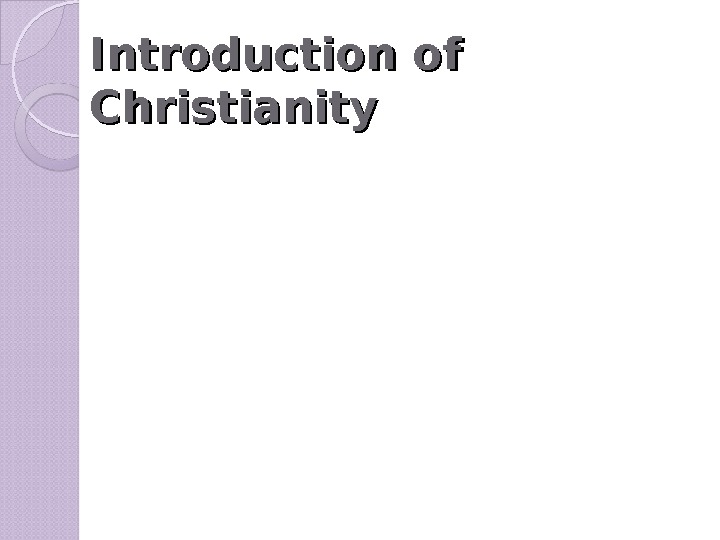
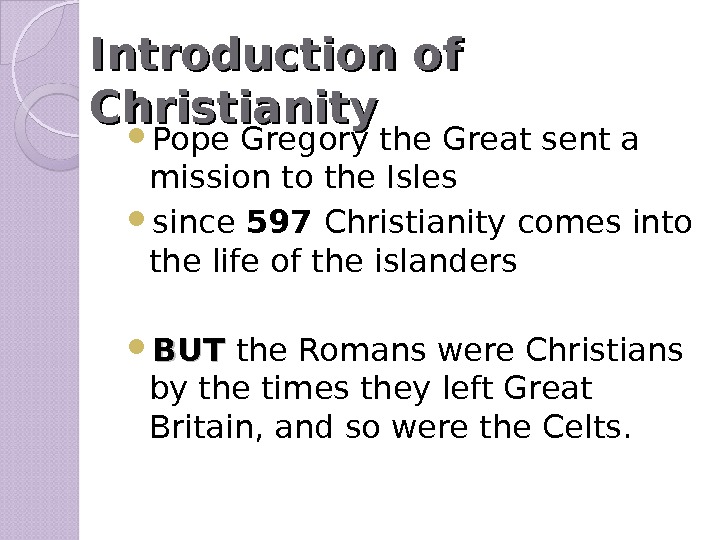
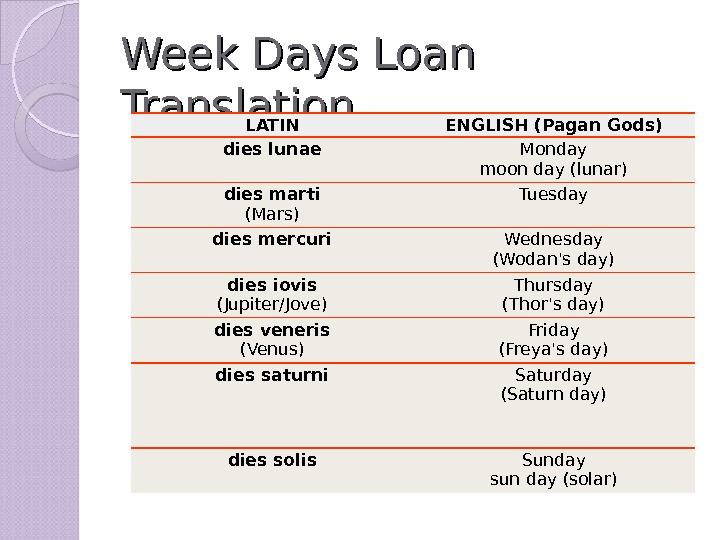
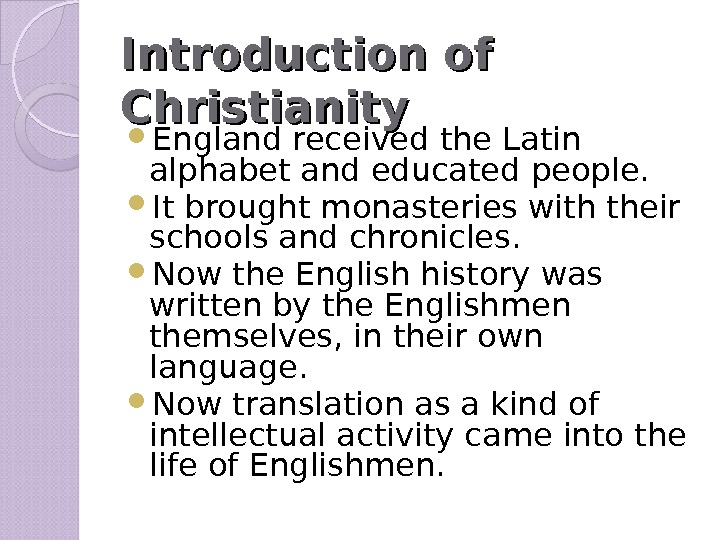

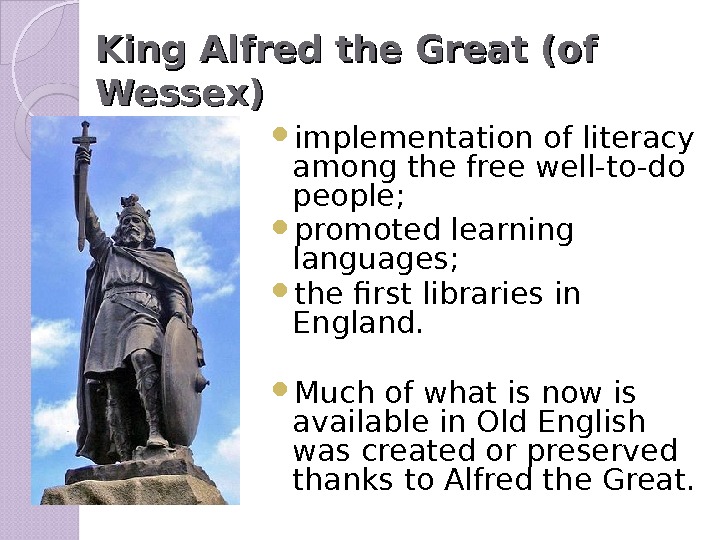
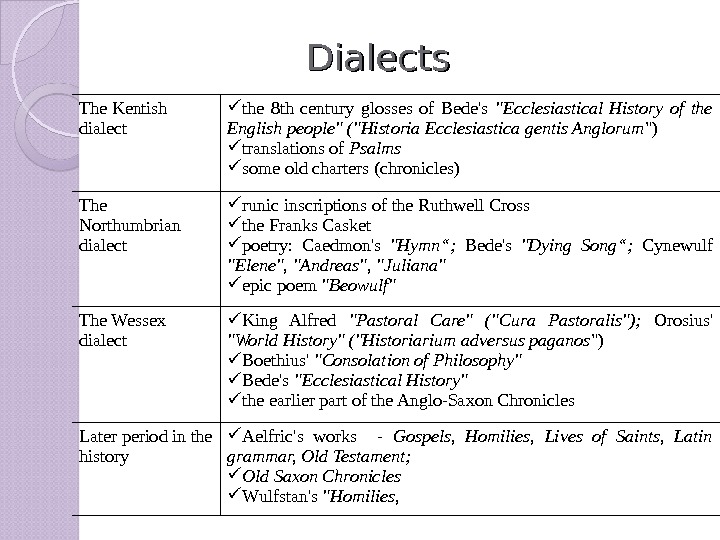
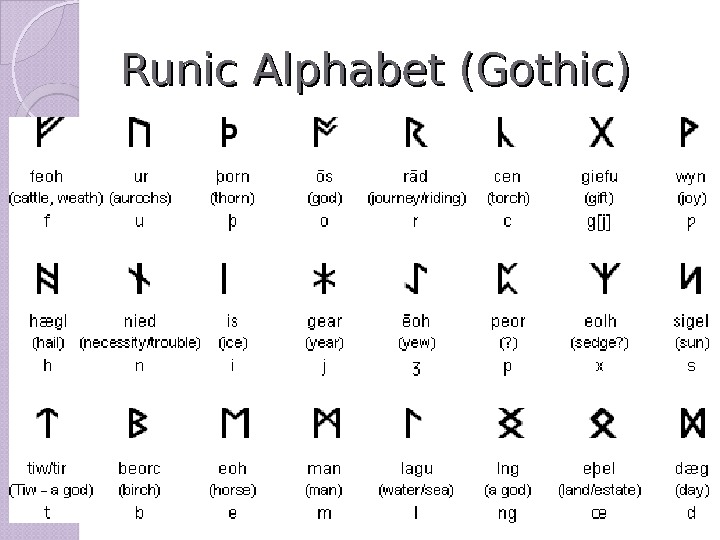
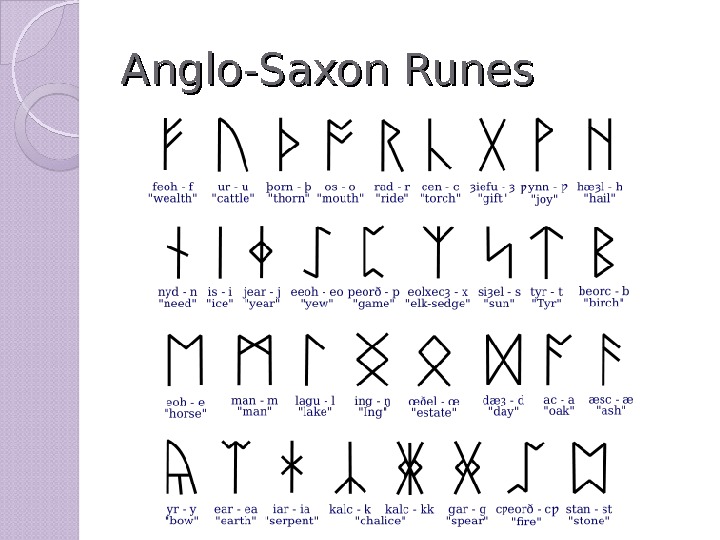
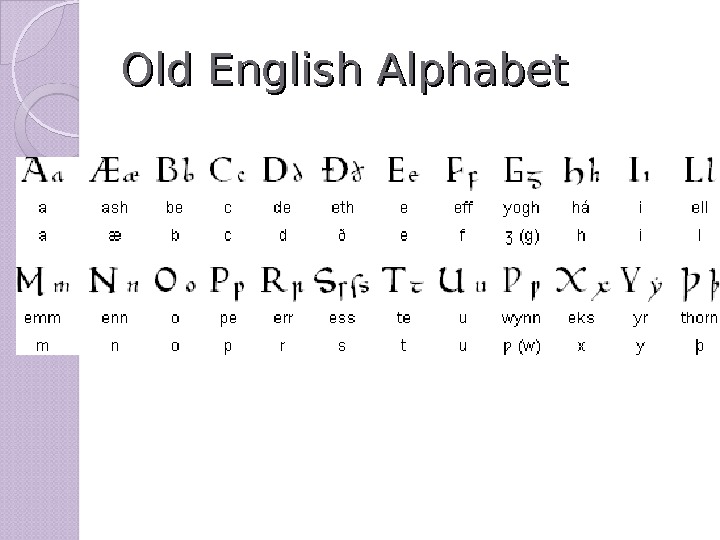
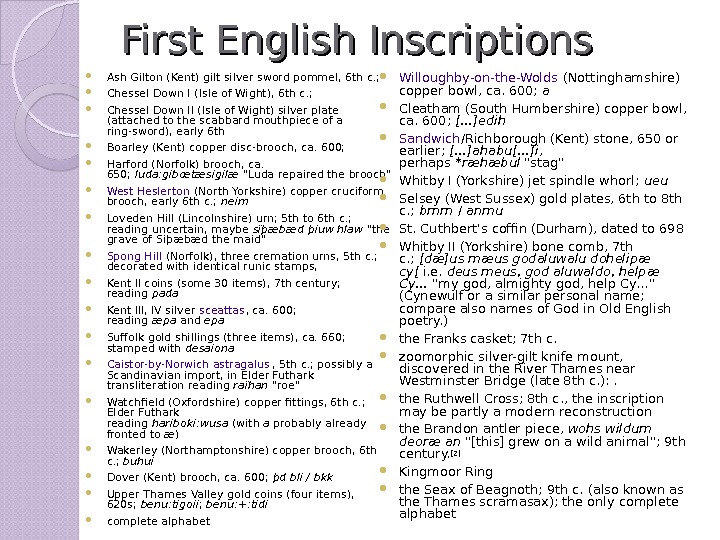
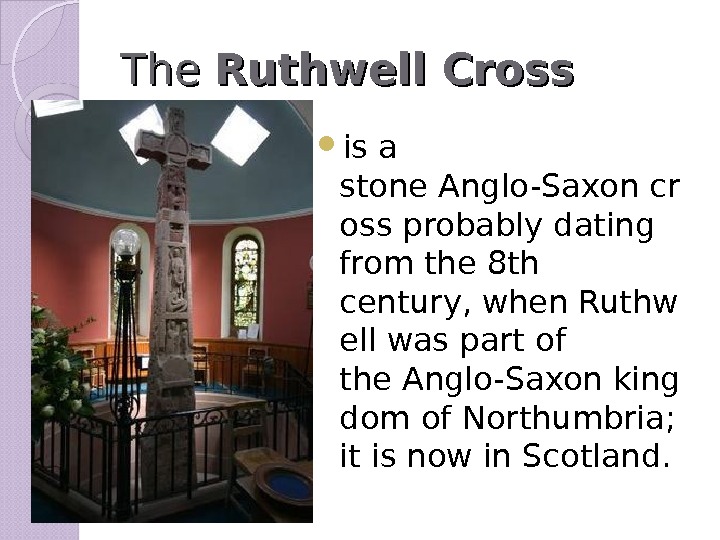
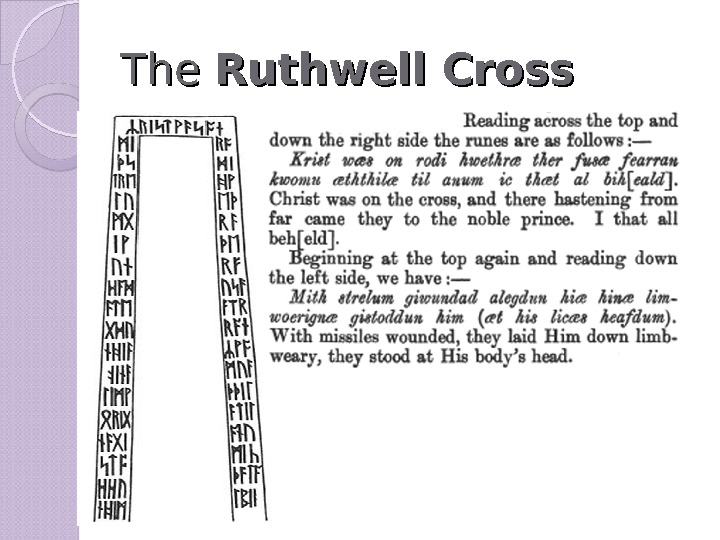
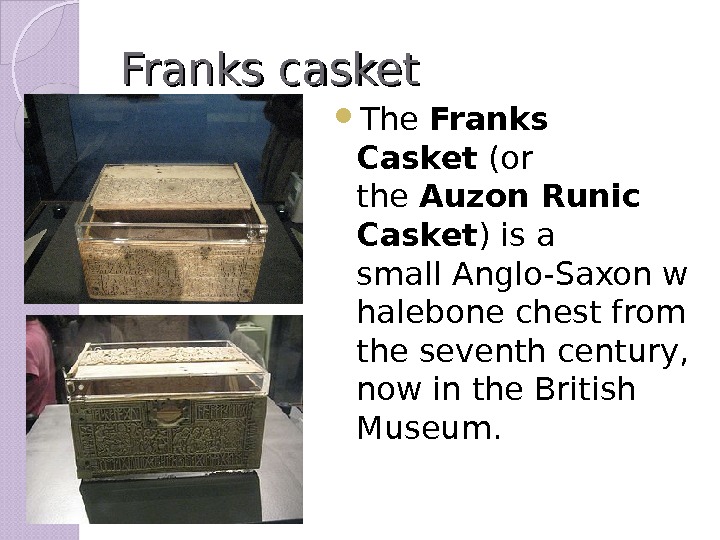
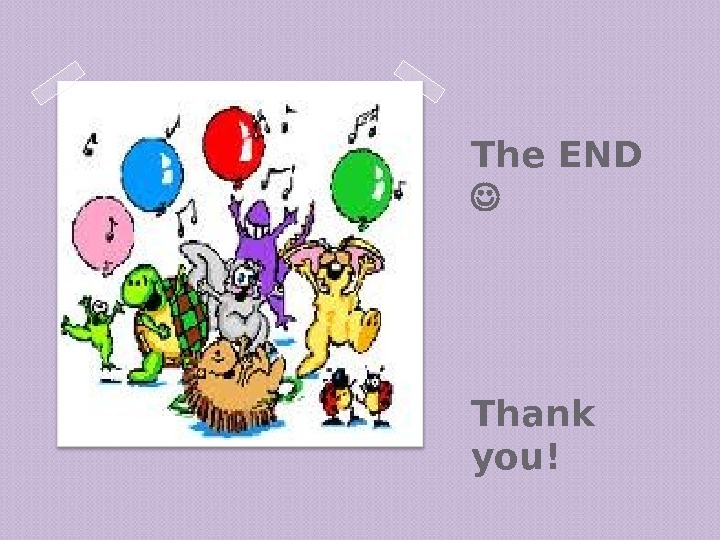
- Размер: 1.8 Mегабайта
- Количество слайдов: 51
Описание презентации History of the English Language 2011 -2012 Academic по слайдам
 History of the English Language 2011 -2012 Academic Year Lecture 1/
History of the English Language 2011 -2012 Academic Year Lecture 1/
 U’ll have the opportunity to to Get involved into the English History Studies Listen to 8 lectures Show your ability to think and develop ideas at 9 practice classes Cope with Multiple choice tests Take a Credit at the end of the Course (IF YOU WISH)
U’ll have the opportunity to to Get involved into the English History Studies Listen to 8 lectures Show your ability to think and develop ideas at 9 practice classes Cope with Multiple choice tests Take a Credit at the end of the Course (IF YOU WISH)
 References The Academy Global. Net Verba L. History of the English Language. – Vinnytsa: Nova knyha, 200 4. Касьянова. Історія англійської мови – Х : ВІ ВВ МВС України , 2005. Аракин В. А. Очерки по истории английского языка, Москва, 1955. Аракин В. А. История английского языка. – Москва, 2003 Бруннер К. История английского языка. – Москва, 1955 Иванова И. П. , Беляева Т. М. . Хрестоматия по истории английского языка — Л. , Просвещение, 1980. Иванова И. П. , Чахоян Л. П. История английского языка. – М. , 1976. Костюченко Ю. П. Історія англійської мови. — К. : Радянська школа, 1963. Смирницкий А. И. История английского языка — М. : Издательство Московского Университета, 1965. Смирницкий А. И. Хрестоматия по истории английского языка с VII по XVII в. — Москва, 1953. Ilyish B. History of the English Language. – Leningrad, 1973 Rastorguyeva T. A. A History of English. – Moscow, 1983.
References The Academy Global. Net Verba L. History of the English Language. – Vinnytsa: Nova knyha, 200 4. Касьянова. Історія англійської мови – Х : ВІ ВВ МВС України , 2005. Аракин В. А. Очерки по истории английского языка, Москва, 1955. Аракин В. А. История английского языка. – Москва, 2003 Бруннер К. История английского языка. – Москва, 1955 Иванова И. П. , Беляева Т. М. . Хрестоматия по истории английского языка — Л. , Просвещение, 1980. Иванова И. П. , Чахоян Л. П. История английского языка. – М. , 1976. Костюченко Ю. П. Історія англійської мови. — К. : Радянська школа, 1963. Смирницкий А. И. История английского языка — М. : Издательство Московского Университета, 1965. Смирницкий А. И. Хрестоматия по истории английского языка с VII по XVII в. — Москва, 1953. Ilyish B. History of the English Language. – Leningrad, 1973 Rastorguyeva T. A. A History of English. – Moscow, 1983.
 Welcome!
Welcome!
 Lecture 1. 1 The Subject Matter of the Course Periods in the English Language Development Old English Period — historical background
Lecture 1. 1 The Subject Matter of the Course Periods in the English Language Development Old English Period — historical background
 1. The Subject Matter of the Course
1. The Subject Matter of the Course
 History of the English language studies the rise and development of English, its structure and peculiarities in the old days, its similarity to other languages of the same family and its unique, specific features.
History of the English language studies the rise and development of English, its structure and peculiarities in the old days, its similarity to other languages of the same family and its unique, specific features.
 Why should u study the History of English? !?
Why should u study the History of English? !?




 Why should u study the History of English? !?
Why should u study the History of English? !?
 Why do we have pet — pets & child — children? to like – liked and to cut – cut? busy & bus? fancy & phantasy? chorus & choir? sir & senior? three & trio? eat, eatable & edible? e [ i: ] & a [ei]? host & hostile? Rules and exceptions will fit into a certain system when you know the history.
Why do we have pet — pets & child — children? to like – liked and to cut – cut? busy & bus? fancy & phantasy? chorus & choir? sir & senior? three & trio? eat, eatable & edible? e [ i: ] & a [ei]? host & hostile? Rules and exceptions will fit into a certain system when you know the history.
 SYNCRONY DIACHRONY
SYNCRONY DIACHRONY
 SYNCRONY DIACHRONY The study of a language as a system of interrelated phenomena at any given point in time. The study ofchange or development in a linguistic system overa period of time.
SYNCRONY DIACHRONY The study of a language as a system of interrelated phenomena at any given point in time. The study ofchange or development in a linguistic system overa period of time.
 Our plan for this term: We are going to have a close look at the major stages of development of the language, the influence of various linguistic and non-linguistic factors on the language and, try and formulate what makes this language, once a language of one of the many not very significant European communities, now almost a Lingua Franca, a means of communication on the global scale however willing or unwilling should the peoples and politicians be to admit it.
Our plan for this term: We are going to have a close look at the major stages of development of the language, the influence of various linguistic and non-linguistic factors on the language and, try and formulate what makes this language, once a language of one of the many not very significant European communities, now almost a Lingua Franca, a means of communication on the global scale however willing or unwilling should the peoples and politicians be to admit it.
 Language Families
Language Families
 Indo-European Family: Indo-Iranian group Greek group Italic (Latin) group Celtic group Germanic group (480 million speakers) Baltic group Slavic group (250 million speakers) Armenian group Albanian group
Indo-European Family: Indo-Iranian group Greek group Italic (Latin) group Celtic group Germanic group (480 million speakers) Baltic group Slavic group (250 million speakers) Armenian group Albanian group
 Indo-European Family: Indo-Iranian group Greek group Italic (Latin) group Celtic group Germanic group Baltic group Slavic group (250 million speakers) Armenian group Albanian group Western branch Northern (Scandinavian) branch Eastern branch
Indo-European Family: Indo-Iranian group Greek group Italic (Latin) group Celtic group Germanic group Baltic group Slavic group (250 million speakers) Armenian group Albanian group Western branch Northern (Scandinavian) branch Eastern branch
 Indo-European Family: Indo-Iranian group Greek group Italic (Latin) group Celtic group Germani c group Baltic group Slavic group (250 million speakers) Armenian group Albanian group Western branch English, Frisian; Dutch, Afrikaans, Northern German; Franconian, German, Eastern Franconian, Southern Franconian, Bavarian, Alemannic, Yiddish (Ashkenazi) and Pensilfaanisch (Amish in USA) Northern (Scandinavian) branch Icelandic, Norwegian, Faroese; Danish, Swedish Eastern branch (extinct) Burgundian, Gothic, Vandalic, Crimean Gothic
Indo-European Family: Indo-Iranian group Greek group Italic (Latin) group Celtic group Germani c group Baltic group Slavic group (250 million speakers) Armenian group Albanian group Western branch English, Frisian; Dutch, Afrikaans, Northern German; Franconian, German, Eastern Franconian, Southern Franconian, Bavarian, Alemannic, Yiddish (Ashkenazi) and Pensilfaanisch (Amish in USA) Northern (Scandinavian) branch Icelandic, Norwegian, Faroese; Danish, Swedish Eastern branch (extinct) Burgundian, Gothic, Vandalic, Crimean Gothic
 The roots of English: originally the dialects of a comparatively small number of related tribes that migrated from the continent onto the British isles, the dialects of the Indo-European family — synthetic, inflected language with: a well-developed system of noun forms, a rather poorly represented system of verbal categories, with free word order and a vocabulary that consisted almost entirely of words of native origin.
The roots of English: originally the dialects of a comparatively small number of related tribes that migrated from the continent onto the British isles, the dialects of the Indo-European family — synthetic, inflected language with: a well-developed system of noun forms, a rather poorly represented system of verbal categories, with free word order and a vocabulary that consisted almost entirely of words of native origin.
 2. Periods in the English Language Development
2. Periods in the English Language Development
 ANCIENT HISTORY OF BRITAIN THE EARLIEST INHABITANTS The Iberians 3000 B. C. The Scots, the Picts 2000 B. C. The Gaels 700 B. C. The Celts The Britons 500 B. C. The Belgae 100 B. C. The Roman Conquest: J. Caesar 55 B. C. Claudius 43 A. D. The Anglo-Saxon Conquest: Hengest and Horsa 449 A. D.
ANCIENT HISTORY OF BRITAIN THE EARLIEST INHABITANTS The Iberians 3000 B. C. The Scots, the Picts 2000 B. C. The Gaels 700 B. C. The Celts The Britons 500 B. C. The Belgae 100 B. C. The Roman Conquest: J. Caesar 55 B. C. Claudius 43 A. D. The Anglo-Saxon Conquest: Hengest and Horsa 449 A. D.
 The beginnings of the English language are traced back to year 449, when coming to help their Celtic ally, two Germanic chieftains, Hengist and Horsa, brought their belligerent tribesmen to the Isles.
The beginnings of the English language are traced back to year 449, when coming to help their Celtic ally, two Germanic chieftains, Hengist and Horsa, brought their belligerent tribesmen to the Isles.
 So starting as a language separated from the rest of the Germanic linguistic area, English has been functioning for more than a millennium and a half; and there can be traced several periods within its history.
So starting as a language separated from the rest of the Germanic linguistic area, English has been functioning for more than a millennium and a half; and there can be traced several periods within its history.
 PERIODIZATION OF THE HISTORY OF THE ENGLISH LANGUAGE Centur ies Period (H. Sweet) Period subdivisi on / early–late / Beginning End V(VII)– XI 449 -10 66 Old English Period of full endings EOE VII-VIII LOE IX-XI The Germanic Settlement The Norman Conquest XII – XV Middle English Period of levelled endings EME XII-XIII LME XIV-XVI The Norman Conquest The Introductio n of Printing (1475) – Chaucer’s Age` XVI – presen t day New English Period of lost endings ENE XVII-XVIII LNE XIX-XXI Shakespea re’s Time
PERIODIZATION OF THE HISTORY OF THE ENGLISH LANGUAGE Centur ies Period (H. Sweet) Period subdivisi on / early–late / Beginning End V(VII)– XI 449 -10 66 Old English Period of full endings EOE VII-VIII LOE IX-XI The Germanic Settlement The Norman Conquest XII – XV Middle English Period of levelled endings EME XII-XIII LME XIV-XVI The Norman Conquest The Introductio n of Printing (1475) – Chaucer’s Age` XVI – presen t day New English Period of lost endings ENE XVII-XVIII LNE XIX-XXI Shakespea re’s Time
 3. The Old English Period
3. The Old English Period
 The Old English Period , in our study is the period from the fifth up to mid-eleventh century.
The Old English Period , in our study is the period from the fifth up to mid-eleventh century.
 It is characterised by language in the form of several dialects (7 kingdoms that existed on the island); the vocabulary of each of them is comparatively homogeneous (words of native origin (Indo-European, Germanic and specifically English); a ramified system of endings, hence relatively free word order; Common Indo-European traits (double negation or formation of impersonal sentences); noticeable drift of the sound system away from other Germanic languages;
It is characterised by language in the form of several dialects (7 kingdoms that existed on the island); the vocabulary of each of them is comparatively homogeneous (words of native origin (Indo-European, Germanic and specifically English); a ramified system of endings, hence relatively free word order; Common Indo-European traits (double negation or formation of impersonal sentences); noticeable drift of the sound system away from other Germanic languages;
 The BACKGROUND against which the English language was forming included long years of pre-written functioning of the language. Very soon the remnants of the Celtic population were subjugated, or ousted into the outskirts of the Isles — to the North (Scotland), or to the West (Cornwall and Wales). The invaders-”peacekeepers” felt comfortable on the new territory.
The BACKGROUND against which the English language was forming included long years of pre-written functioning of the language. Very soon the remnants of the Celtic population were subjugated, or ousted into the outskirts of the Isles — to the North (Scotland), or to the West (Cornwall and Wales). The invaders-”peacekeepers” felt comfortable on the new territory.

 OLD ENGLISH KINGDOMS AND DIALECTS The Tribes The Parts of England The Kingdoms The Main Dialects The Jutes (Frisians) Kent and the Isle of Wight Kentish The Saxons South of the Thames Wessex, Essex, Sussex West Saxon, East Saxon The Angles North of the Thames East Anglia, Mercia, Northumbria Anglian, Mercian, Northumbrian
OLD ENGLISH KINGDOMS AND DIALECTS The Tribes The Parts of England The Kingdoms The Main Dialects The Jutes (Frisians) Kent and the Isle of Wight Kentish The Saxons South of the Thames Wessex, Essex, Sussex West Saxon, East Saxon The Angles North of the Thames East Anglia, Mercia, Northumbria Anglian, Mercian, Northumbrian
 HEPTARCHY 7 TH -8 TH centuries
HEPTARCHY 7 TH -8 TH centuries
 HEPTARCHY 7 TH -8 TH centuries Supremacy at different times: Kent, Mercia Northumbria
HEPTARCHY 7 TH -8 TH centuries Supremacy at different times: Kent, Mercia Northumbria
 Extant documents written in the language date from about 700 to about 1100, but the great bulk of written material represents the speech from about 900 to 1050. The language was represented in writing in four dialects : Northumbrian, Mercian, Kentish, and West-Saxon. The dominance of the West-Saxon literature during the period demonstrates the political and artistic vitality of the kingdom of West Saxons (Wessex). West-Saxon literature is the ancestor of nearly all English literature, but the West-Saxon language is not.
Extant documents written in the language date from about 700 to about 1100, but the great bulk of written material represents the speech from about 900 to 1050. The language was represented in writing in four dialects : Northumbrian, Mercian, Kentish, and West-Saxon. The dominance of the West-Saxon literature during the period demonstrates the political and artistic vitality of the kingdom of West Saxons (Wessex). West-Saxon literature is the ancestor of nearly all English literature, but the West-Saxon language is not.
 Introduction of Christianity
Introduction of Christianity
 Introduction of Christianity Pope Gregory the Great sent a mission to the Isles since 597 Christianity comes into the life of the islanders BUT the Romans were Christians by the times they left Great Britain, and so were the Celts.
Introduction of Christianity Pope Gregory the Great sent a mission to the Isles since 597 Christianity comes into the life of the islanders BUT the Romans were Christians by the times they left Great Britain, and so were the Celts.
 Week Days Loan Translation LATIN ENGLISH (Pagan Gods) dies lunae Monday moon day (lunar) dies marti (Mars) Tuesday dies mercuri Wednesday (Wodan’s day) dies iovis (Jupiter/Jove) Thursday (Thor’s day) dies veneris (Venus) Friday (Freya’s day) dies saturni Saturday (Saturn day) dies solis Sunday sun day (solar)
Week Days Loan Translation LATIN ENGLISH (Pagan Gods) dies lunae Monday moon day (lunar) dies marti (Mars) Tuesday dies mercuri Wednesday (Wodan’s day) dies iovis (Jupiter/Jove) Thursday (Thor’s day) dies veneris (Venus) Friday (Freya’s day) dies saturni Saturday (Saturn day) dies solis Sunday sun day (solar)
 Introduction of Christianity England received the Latin alphabet and educated people. It brought monasteries with their schools and chronicles. Now the English history was written by the Englishmen themselves, in their own language. Now translation as a kind of intellectual activity came into the life of Englishmen.
Introduction of Christianity England received the Latin alphabet and educated people. It brought monasteries with their schools and chronicles. Now the English history was written by the Englishmen themselves, in their own language. Now translation as a kind of intellectual activity came into the life of Englishmen.
 King Alfred the Great (of Wessex) the Wedmore peace treaty of 878 Danelaw This treaty allowed a relatively stable period in the development of the rest of the country; more than that, the very personality of Alfred seems to be one of the most prominent educators of the nation.
King Alfred the Great (of Wessex) the Wedmore peace treaty of 878 Danelaw This treaty allowed a relatively stable period in the development of the rest of the country; more than that, the very personality of Alfred seems to be one of the most prominent educators of the nation.
 King Alfred the Great (of Wessex) implementation of literacy among the free well-to-do people; promoted learning languages; the first libraries in England. Much of what is now is available in Old English was created or preserved thanks to Alfred the Great.
King Alfred the Great (of Wessex) implementation of literacy among the free well-to-do people; promoted learning languages; the first libraries in England. Much of what is now is available in Old English was created or preserved thanks to Alfred the Great.
 Dialects The Kentish dialect the 8 th century glosses of Bede’s «Ecclesiastical History of the English people» («Historia Ecclesiastica gentis Anglorum «) translations of Psalms some old charters (chronicles) The Northumbrian dialect runic inscriptions of the Ruthwell Cross the Franks Casket poetry: Caedmon’s «Hymn“; Bede’s «Dying Song“; Cynewulf «Elene», «Andreas», «Juliana» epic poem «Beowulf» The Wessex dialect King Alfred «Pastoral Care» («Cura Pastoralis»); Orosius’ «World History» («Historiarium adversus paganos «) Boethius’ «Consolation of Philosophy» Bede’s «Ecclesiastical History» the earlier part of the Anglo-Saxon Chronicles Later period in the history Aelfric’s works — Gospels, Homilies, Lives of Saints, Latin grammar, Old Testament; Old Saxon Chronicles Wulfstan’s «Homilies,
Dialects The Kentish dialect the 8 th century glosses of Bede’s «Ecclesiastical History of the English people» («Historia Ecclesiastica gentis Anglorum «) translations of Psalms some old charters (chronicles) The Northumbrian dialect runic inscriptions of the Ruthwell Cross the Franks Casket poetry: Caedmon’s «Hymn“; Bede’s «Dying Song“; Cynewulf «Elene», «Andreas», «Juliana» epic poem «Beowulf» The Wessex dialect King Alfred «Pastoral Care» («Cura Pastoralis»); Orosius’ «World History» («Historiarium adversus paganos «) Boethius’ «Consolation of Philosophy» Bede’s «Ecclesiastical History» the earlier part of the Anglo-Saxon Chronicles Later period in the history Aelfric’s works — Gospels, Homilies, Lives of Saints, Latin grammar, Old Testament; Old Saxon Chronicles Wulfstan’s «Homilies,
 Runic Alphabet (Gothic)
Runic Alphabet (Gothic)
 Anglo-Saxon Runes
Anglo-Saxon Runes
 Old English Alphabet
Old English Alphabet
 First English Inscriptions Ash Gilton (Kent) gilt silver sword pommel, 6 th c. ; Chessel Down I (Isle of Wight), 6 th c. ; Chessel Down II (Isle of Wight) silver plate (attached to the scabbard mouthpiece of a ring-sword), early 6 th Boarley (Kent) copper disc-brooch, ca. 600; Harford (Norfolk) brooch, ca. 650; luda: gibœtæsigilæ «Luda repaired the brooch» West Heslerton (North Yorkshire) copper cruciform brooch, early 6 th c. ; neim Loveden Hill (Lincolnshire) urn; 5 th to 6 th c. ; reading uncertain, maybe sïþæbæd þiuw hlaw «the grave of Siþæbæd the maid» Spong Hill (Norfolk), three cremation urns, 5 th c. ; decorated with identical runic stamps, Kent II coins (some 30 items), 7 th century; reading pada Kent III, IV silver sceattas , ca. 600; reading æpa and epa Suffolk gold shillings (three items), ca. 660; stamped with desaiona Caistor-by-Norwich astragalus , 5 th c. ; possibly a Scandinavian import, in Elder Futhark transliteration reading raïhan «roe» Watchfield (Oxfordshire) copper fittings, 6 th c. ; Elder Futhark reading hariboki: wusa (with a probably already fronted to æ ) Wakerley (Northamptonshire) copper brooch, 6 th c. ; buhui Dover (Kent) brooch, ca. 600; þd bli / bkk Upper Thames Valley gold coins (four items), 620 s; benu: tigoii ; benu: +: tidi complete alphabet Willoughby-on-the-Wolds (Nottinghamshire) copper bowl, ca. 600; a Cleatham (South Humbershire) copper bowl, ca. 600; […]edih Sandwich /Richborough (Kent) stone, 650 or earlier; […]ahabu[…]i , perhaps *ræhæbul «stag» Whitby I (Yorkshire) jet spindle whorl; ueu Selsey (West Sussex) gold plates, 6 th to 8 th c. ; brnrn / anmu St. Cuthbert’s coffin(Durham), dated to 698 Whitby II (Yorkshire) bone comb, 7 th c. ; [dæ]us mæus godaluwalu dohelipæ cy[ i. e. deus meus, god aluwaldo, helpæ Cy… «my god, almighty god, help Cy…» (Cynewulfor a similar personal name; compare alsonames of God in Old English poetry. ) the. Franks casket; 7 th c. zoomorphic silver-gilt knife mount, discovered in the River Thames near Westminster Bridge (late 8 th c. ): . the. Ruthwell Cross; 8 th c. , the inscription may be partly a modern reconstruction the Brandon antler piece, wohs wildum deoræ an «[this] grew on a wild animal»; 9 th century. [2] Kingmoor Ring the. Seax of Beagnoth; 9 th c. (also known as the Thames scramasax); the only complete alphabet
First English Inscriptions Ash Gilton (Kent) gilt silver sword pommel, 6 th c. ; Chessel Down I (Isle of Wight), 6 th c. ; Chessel Down II (Isle of Wight) silver plate (attached to the scabbard mouthpiece of a ring-sword), early 6 th Boarley (Kent) copper disc-brooch, ca. 600; Harford (Norfolk) brooch, ca. 650; luda: gibœtæsigilæ «Luda repaired the brooch» West Heslerton (North Yorkshire) copper cruciform brooch, early 6 th c. ; neim Loveden Hill (Lincolnshire) urn; 5 th to 6 th c. ; reading uncertain, maybe sïþæbæd þiuw hlaw «the grave of Siþæbæd the maid» Spong Hill (Norfolk), three cremation urns, 5 th c. ; decorated with identical runic stamps, Kent II coins (some 30 items), 7 th century; reading pada Kent III, IV silver sceattas , ca. 600; reading æpa and epa Suffolk gold shillings (three items), ca. 660; stamped with desaiona Caistor-by-Norwich astragalus , 5 th c. ; possibly a Scandinavian import, in Elder Futhark transliteration reading raïhan «roe» Watchfield (Oxfordshire) copper fittings, 6 th c. ; Elder Futhark reading hariboki: wusa (with a probably already fronted to æ ) Wakerley (Northamptonshire) copper brooch, 6 th c. ; buhui Dover (Kent) brooch, ca. 600; þd bli / bkk Upper Thames Valley gold coins (four items), 620 s; benu: tigoii ; benu: +: tidi complete alphabet Willoughby-on-the-Wolds (Nottinghamshire) copper bowl, ca. 600; a Cleatham (South Humbershire) copper bowl, ca. 600; […]edih Sandwich /Richborough (Kent) stone, 650 or earlier; […]ahabu[…]i , perhaps *ræhæbul «stag» Whitby I (Yorkshire) jet spindle whorl; ueu Selsey (West Sussex) gold plates, 6 th to 8 th c. ; brnrn / anmu St. Cuthbert’s coffin(Durham), dated to 698 Whitby II (Yorkshire) bone comb, 7 th c. ; [dæ]us mæus godaluwalu dohelipæ cy[ i. e. deus meus, god aluwaldo, helpæ Cy… «my god, almighty god, help Cy…» (Cynewulfor a similar personal name; compare alsonames of God in Old English poetry. ) the. Franks casket; 7 th c. zoomorphic silver-gilt knife mount, discovered in the River Thames near Westminster Bridge (late 8 th c. ): . the. Ruthwell Cross; 8 th c. , the inscription may be partly a modern reconstruction the Brandon antler piece, wohs wildum deoræ an «[this] grew on a wild animal»; 9 th century. [2] Kingmoor Ring the. Seax of Beagnoth; 9 th c. (also known as the Thames scramasax); the only complete alphabet
 The. The Ruthwell Cross is a stone. Anglo-Saxoncr ossprobably dating from the 8 th century, when. Ruthw ellwas part of the. Anglo-Saxonking dom of Northumbria; it is now in. Scotland.
The. The Ruthwell Cross is a stone. Anglo-Saxoncr ossprobably dating from the 8 th century, when. Ruthw ellwas part of the. Anglo-Saxonking dom of Northumbria; it is now in. Scotland.
 The. The Ruthwell Cross
The. The Ruthwell Cross
 Franks casket The Franks Casket (or the Auzon Runic Casket ) is a small. Anglo-Saxonw halebonechest from the seventh century, now in the. British Museum.
Franks casket The Franks Casket (or the Auzon Runic Casket ) is a small. Anglo-Saxonw halebonechest from the seventh century, now in the. British Museum.
 The END Thank you!
The END Thank you!
